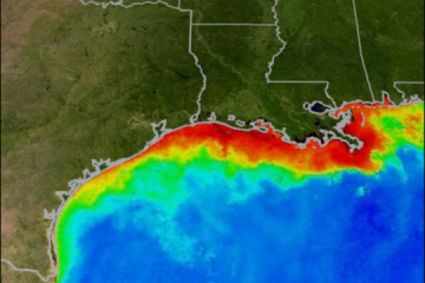Massive dead zone recorded in the Gulf
Last updated 8/1/2016 at Noon
Amid summer of toxic algae, massive dead zone recorded in the Gulf of Mexico.
On Friday, NOAA announced that they have cancelled the annual measurement of the Dead Zone for the first time in 26 years. This year, NOAA required researchers to use a different boat than they have in their past 29 of 30 Dead Zone measuring trip, and due to mechanical issues aboard the new vessel, the trip is cancelled. According to estimates, the 2016 Dead Zone would have measured somewhere between 5,989 and 6,824 square miles, approximately the size of Connecticut.
“This is yet another example of how state and federal agencies do not prioritize cleaning up the Dead Zone,” said Matt Rota, Senior Policy Director for Gulf Restoration Network. “Requiring researchers to use NOAA boats has jeopardized long-term measurements of toxic pollution in our Gulf.”
Nitrogen and phosphorus pollution flowing down the Mississippi River causes the Gulf Dead Zone to form each summer. The pollution causes massive algae growth, which in turn causes the depletion of almost all of the oxygen from Zone. Sea life must swim away from these areas or suffocate and die.
“Every year, we see no reduction in the size of the Dead Zone or the pollution draining into it,” said Matt Rota, Senior Policy Director for Gulf Restoration Network. “Scientists have been measuring this ecological disaster since 1985, and all we have seen from the states and EPA is more reliance on voluntary requirements for polluters. The Dead Zone is an ecological emergency and a disgrace to environmental policy makers. The cancelled trip shows that cleaning up the Dead Zone is not a priority for NOAA, even though clean-up is a priority for those of us who live in, eat from and enjoy the Gulf.”
Nitrogen and phosphorus pollution harms more than just the Louisiana coast. From contaminating the Des Moines and Toledo water supplies to causing destructive algae blooms throughout the Gulf, nitrogen and phosphorus pollution and its associated algae have made living difficult in several areas in the country. This summer, foul-smelling cyanobacteria covered many of Florida’s waters, forcing people from their homes and killing wildlife.
GRN and members of the Mississippi River Collaborative have been pushing EPA and the states to set numeric standards for nitrogen and phosphorus pollution that are necessary to restore clean water in the Gulf of Mexico and throughout the Mississippi River Basin.
The Hypoxia Task Force, formed in 1997 and made up of Mississippi River State and Federal representatives, was tasked to reduce the Dead Zone to less than 2,000 square miles by 2015. “In order to address a pollution problem, we need to set enforceable pollution limits,” said Rota. “The Hypoxia Task Force has been meeting for almost two decades, focusing on voluntary reduction methods. That obviously has not been successful.”
The pollution causing the Dead Zone comes from various sources from urban run-off to the discharges from sewage treatment plants and industrial facilities. However, agriculture has been identified as the largest source of Dead Zone-causing pollution in Mississippi River states and all the way down to the Gulf. Still there are virtually no standards that the agriculture industry must meet to address these problems.
"We all need to be accountable for clean water,” said Susan Heathcote, Water Program Director for the Iowa Environmental Council. “Changes are needed to get basic soil and water conservation practices on all farms to keep soil and fertilizer on the land and out of the water. These basic practices include improved fertilizer and manure management, reduced tillage, placing grass filter strips between cropland and waterways, and planting of cover crops after harvest.”












Reader Comments(0)